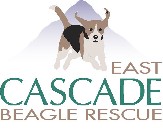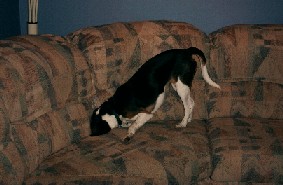
Featured Articles

Mission Statement
To place Beagles in need into
loving, permanent homes and to provide educational resources to help
prevent future displaced Beagles.
Our program is funded by private
donations. Your support is appreciated!
Fall 2006
Training my Beagle - what am I doing?
Reinforcement vs. Punishment
 |
|
CBR-East Director Carolyn's bad boy, Pippin - looking for crumbs in the couch |
We all love the experience of bringing home the new adopted addition to our family...whether it be an 8 week old beagle puppy, or a special 10 year old senior beagle. The first few days are filled with excitement, and then...well...they start doing things that we wish they didn't - jumping up on us, counter-surfing, peeing in the house, chewing our couches, etc. So, we read our training handouts from CBR-East, and we still need help. We write to the adopters' group, and seek help from the knowledgeable folks in the group, and get some personalized assistance from one of the trainers/behaviorists. We all need additional information from you about what is going on, and one of those things is: what are you currently doing to handle the behavior? This helps us understand the dog's learning history, and what may be maintaining the behavior. Because you see - behaviors only continue if they serve a purpose...if we understand the purpose, we can figure out how to change it so that the dog still gets what he needs, and we can still have a well behaved beagle. (Is there such a thing? LOL!)
Almost every person who writes to us or applies to adopt says they handle behaviors through positive reinforcement. GREAT! Others write and say they would never use negative reinforcement or punish their dog. Well, actually, people use these terms as if they are synonymous, and they are very far from being the same thing!! Despite what people think, negative reinforcement is not punishment. This article is the first of two to help folks understand these terms - reinforcement, punishment, positive reinforcement, negative reinforcement, positive punishment and negative punishment. Unfortunately, many of these terms are misused even by trainers, but these are the facts - direct from the behaviorism research/literature! I will water them down a bit to help make them more understandable, but if you can understand these terms, you can have a better idea of how to help change your dog's undesirable behaviors.
![]() Reinforcement: this does not mean "being nice" or giving a
treat. :) Reinforcement can be described as a
consequence (to a behavior) which increases the likelihood that the
behavior will occur again in the future.
Reinforcement: this does not mean "being nice" or giving a
treat. :) Reinforcement can be described as a
consequence (to a behavior) which increases the likelihood that the
behavior will occur again in the future.
![]() Punishment: this does not mean "being mean" or hitting your
dog. Punishment can be described as a
consequence (to a behavior) which decreases the likelihood that the
behavior will occur again in the future.
Punishment: this does not mean "being mean" or hitting your
dog. Punishment can be described as a
consequence (to a behavior) which decreases the likelihood that the
behavior will occur again in the future.
HUH? People inherently think of reinforcement as "good" and punishment as "bad," and then when people hear the terms positive reinforcement and negative reinforcement, they think of positive as being good, and negative as being bad. This is not accurate. Let's deal with one thing at a time.
**Think of reinforcement as INCREASING a behavior, and punishment as DECREASING a behavior.**
Got it? GOOD! :)
When we train our beagles, we want to use REINFORCEMENT! Let's use Pippin, one of my own beagles as an example. Pippin likes to jump on people when he greets them. How can we fix this? Through REINFORCEMENT. But don't we want to DECREASE his jumping by PUNISHING his jumping? Well, sure, you could use that. But with beagles, you get better results by REINFORCING (and positive reinforcement at that, which I will get into in next month's featured article...), so instead of PUNISHING his JUMPING when someone walks into the room, let's tell him to SIT, and REINFORCE his SITTING when people come into the room. Make sense? We can actually decrease jumping by increasing sitting, so we can use reinforcement instead of punishment. :) YEAH!
 |
| Sit! He does, so pet him while saying "good boy"... |
Try to think of something else you can teach your beagle to do INSTEAD of the behavior they are currently doing. You can then use reinforcement to teach them instead of punishment.
By changing what occurs AFTER a behavior, you can change the behavior itself. So, if Pippin jumps up on people when he greets them, and those people pet him, Pippin gets reinforced for jumping. Here we are reinforcing jumping because since Pippin likes to be pet, it is likely that the next time he greets someone, he will jump up on them to get pet again.
As we mentioned above, instead of punishing jumping to decrease it - by doing something to Pippin that he does not like which will decrease his likelihood to jump in the future, let's reinforce (INCREASE) a DIFFERENT behavior! SITTING. So, let's teach Pippin to sit when he greets someone. Then we can ask people who enter the room to pet him only when he is sitting, or if someone else asked him to sit, for them also to pet him. In other words, pet him and reinforce him for sitting when he greets people. In time, Pippin will learn that jumping gets him nothing, and sitting gets him attention and pets!
More on positive and negative reinforcement and punishment next month...
Questions? Email me.
Carolyn Sterner, M.Ed., BCBA
(Board Certified Behavior Analyst)
Director, CBR-East
Click here to visit the article archives.
Mission Statement
To place Beagles in need into
loving, permanent homes and to provide educational resources to help
prevent future displaced Beagles.
Our program is funded by private
donations. Your support is appreciated!